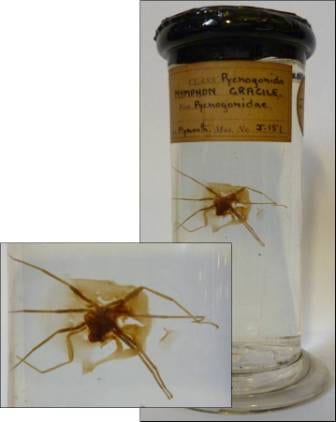Specimen of the Week: Week 103
By Emma-Louise Nicholls, on 30 September 2013
 These past few weeks some of our exhibits have been rearranged and reinvented. This has included the merciless culling of some specimens, doomed to a life with the other relegated objects in the well-populated store rooms (the existence of which is primarily due to not having enough space to display everything). As I packed them up for transportation, one of them leapt out at me (not literally) and I thought it deserved one last hoorah before it is consigned to the group of specimens to be loved only from afar. And only by those who know it is there. This week’s Specimen of the Week is…
These past few weeks some of our exhibits have been rearranged and reinvented. This has included the merciless culling of some specimens, doomed to a life with the other relegated objects in the well-populated store rooms (the existence of which is primarily due to not having enough space to display everything). As I packed them up for transportation, one of them leapt out at me (not literally) and I thought it deserved one last hoorah before it is consigned to the group of specimens to be loved only from afar. And only by those who know it is there. This week’s Specimen of the Week is…
**The sea-spider**

The sea-spider (Nymphon gracile) at the
Grant Museum. It hasn’t been squashed
by a slipper, it is attached to a glass
backplate by glue that has gone brown.
LDUCZ-J151
1) The sea-spider is a marine arthropod called a pycnogonid, not a real spider at all. So check your phobias at the door, they’re not necessary here (that’s how they work right?) It does look a lot like a terrestrial spider though, and it also lives in the sea. Hence the name. The head has a not insignificant number of appendages- two different pairs for feeding (called chelifores) that are tipped with pincers, a proboscis which has the mouth, and a pair of pseudo-legs that are for carrying eggs. Both males and females have these egg-carrying ‘legs’. The sea-spider has four pairs of actual legs (it’s all about the symmetry) that erupt from the long thin stick-like abdomen. Indeed the body is excruciatingly thin, illiciting the urge to give it a good meal I find.
2) If you were to diligently try and feed it up, you’d need to get yourself a good supply of small worms (of the marine variety of course), some sea-anemones and perhaps a few whelk eggs.

The spindly sea-spider. (Image taken by
Dr. F. Ehrenstrom and L. Beyer. Gettyimages.com. Image
obtained from www.ARKive.org).jpg
3) This species of sea-spider (Nymphon gracile, in case you are interested) is a European. It inhabits the shores of north-west Europe, as well as the lovely coasts of Britain. To find one you need to meander along the the middle or lower shore (for which you may need SCUBA gear) and literally don’t leave any stone unturned. Also check amongst the seaweed.
4) Being a sea-dwelling type of creature, the sea-spider learnt to swim. Although it lives in shallow water, being only a few centimetres long, even shallow water is deep to the sea-spider, so the ability to swim is a good skill to have acquired. The breeding season is in the winter, during which individuals migrate to the sublittoral zone, which essentially means- much deeper water.
5) To breed, the female will release eggs through openings on her legs near her abdomen. The male and female will (adoringly) cling together during ‘mating’, and the eggs are fertilised externally. Although both the male and the female have egg-carrying appendages sprouting from the head, it is the male that carries the fertilised eggs around. The hatchling sea-spiders resemble the adults and grow by shedding their external skeleton, just like terrestrial (real) spiders. They become fully grown at around the age of five months and live to around a year.
Emma-Louise Nicholls is the Museum Assistant at the Grant Museum of Zoology
 Close
Close

